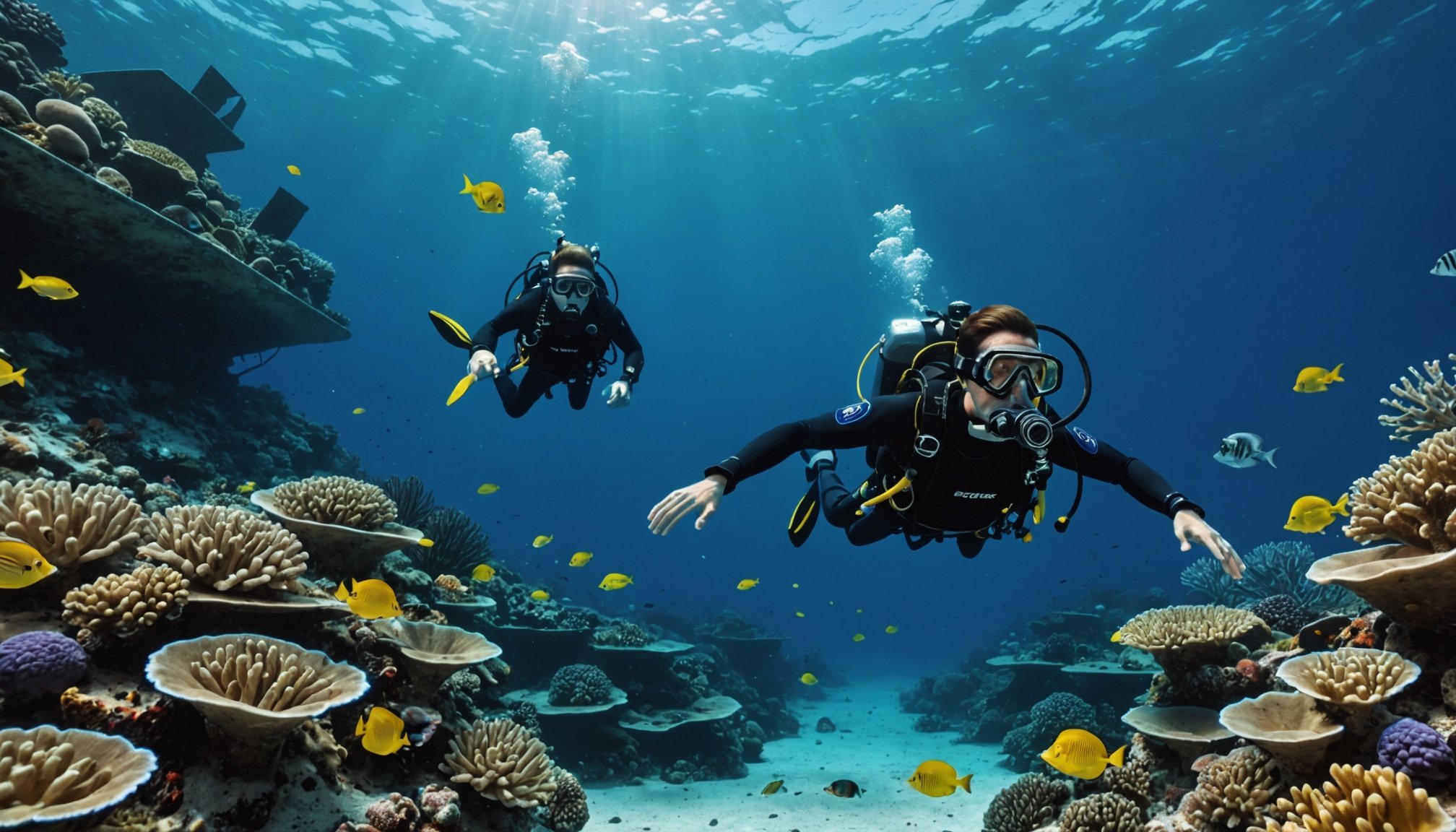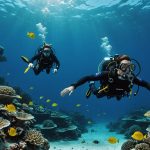Transforming Underwater Exploration: Leveraging AI for Unmatched Realism in Dive Simulations
The Evolution of Underwater Exploration
Underwater exploration has long been a realm of human curiosity and scientific inquiry. From the early days of diving with simple gear to the sophisticated use of Remotely Operated Vehicles (ROVs) and Autonomous Underwater Vehicles (AUVs), technology has played a pivotal role in advancing our understanding of the ocean. However, the latest frontier in this field involves the integration of artificial intelligence (AI) and cutting-edge simulation technologies to create unparalleled realism in dive simulations.
The Role of AI in Underwater Simulations
AI is revolutionizing the way we approach underwater exploration by enhancing the realism and effectiveness of dive simulations. Here are some key ways AI is making a difference:
Also read : Mastering Fluid VR Experiences: The Ultimate Guide for Developers on Enhancing Mode Transitions
Advanced Simulation Environments
AI-driven simulators like the Aerial-Aquatic Manipulators (AAMs) in SEa, Air, and Land Simulator (SEALS) are setting new standards for realism. SEALS, built on NVIDIA Isaac Sim, allows AAMs to operate and learn in integrated environments spanning sea, air, and land. This simulator tackles significant challenges such as creating integrated controllers for flying, swimming, and manipulation, and simulating aerial dynamics and hydrodynamics using particle physics[1].
High-Fidelity Models
The use of high-fidelity models is crucial for simulating real-world conditions. For instance, the Virtual Museum of Underwater Malta uses photogrammetry to create detailed, high-resolution 3D models of submerged cultural sites. These models are not just visually stunning but also serve as benchmarks for monitoring the condition of these sites over time[5].
Also to read : Transforming Mobile Gaming Experiences: How AI-Driven Analytics Shape Tailored Player Journeys
Machine Learning and Deep Learning
Machine learning and deep learning algorithms are being used to enhance the learning experience in underwater simulations. For example, AAM-SEALS employs cutting-edge visual reinforcement learning to improve the performance of AAMs in complex tasks like searching and capturing moving aquatic animals[1].
Key Technologies Driving Realism in Dive Simulations
Several technologies are converging to create highly realistic dive simulations:
Virtual Reality (VR) and Augmented Reality (AR)
Virtual reality is being used to bring the ocean to people in a way that feels real and immersive. Dr. Erika Woolsey’s non-profit, The Hydrous, uses VR to take people on virtual underwater journeys, allowing them to explore coral reefs and interact with marine life in a 360° and 3D environment[2].
Augmented reality is also transforming the way we engage with underwater environments. For instance, Puzzle Tubes’ Deep Ocean AR Puzzle turns a traditional jigsaw puzzle into a living, breathing ocean experience, complete with 3D animations and immersive soundscapes[3].
Fluid Dynamics and Hydrodynamics
Simulating the complex interactions between fluids and objects is essential for realistic underwater simulations. Particle-based hydrodynamics, as used in AAM-SEALS, directly models fluids as a set of particles that interact with each other and surrounding objects, enabling the simulation of complex fluid dynamics and object-fluid interactions[1].
Robotics and Autonomous Systems
The integration of robotics and autonomous systems is another critical aspect. ROVs and AUVs are increasingly being used for non-destructive testing, mapping tasks, and other underwater operations. These systems are designed to meet specific demands and are tailored to enhance efficiency in construction and inspection tasks[4].
Practical Applications and Use Cases
The advancements in AI-driven underwater simulations have numerous practical applications:
Training and Education
- Diver Training: Realistic simulations can train divers in a safe and controlled environment, reducing the risks associated with real-world dives.
- Marine Biology Education: Virtual reality experiences like those offered by The Hydrous can educate people about marine life and the importance of ocean conservation[2].
Research and Exploration
- Underwater Archaeology: The Virtual Museum of Underwater Malta provides detailed 3D models of submerged cultural sites, aiding in research and preservation efforts[5].
- Environmental Monitoring: High-fidelity simulations can help in monitoring the health of marine ecosystems and tracking changes over time.
Industrial and Commercial Uses
- Offshore Construction: ROVs and AUVs equipped with AI can perform complex tasks such as underwater construction and inspection with greater precision and efficiency[4].
- Search and Rescue: AI-driven simulations can help in training for search and rescue operations, improving response times and effectiveness.
Table: Comparison of Underwater Simulation Technologies
| Technology | Description | Realism Level | Use Cases |
|---|---|---|---|
| AAM-SEALS | Photorealistic simulator for aerial-aquatic manipulators | High | Research, training, cross-medium tasks |
| Virtual Museum of Malta | High-resolution 3D models of submerged cultural sites | High | Education, research, preservation |
| The Hydrous VR | Virtual reality underwater journeys | High | Education, public awareness |
| Puzzle Tubes AR Puzzle | Augmented reality jigsaw puzzle transforming into an ocean experience | Medium-High | Education, entertainment |
| ROVs and AUVs | Remotely operated and autonomous underwater vehicles | High | Industrial, commercial, research |
Challenges and Future Directions
While AI-driven underwater simulations have made significant strides, there are still several challenges to overcome:
Integration of Complex Systems
- Integrating AI with other technologies like robotics, VR, and AR to create seamless and realistic experiences.
- Addressing the modifiability challenges faced by many simulators, especially those built on Unreal Engine[1].
Real-World Validation
- Ensuring that simulated environments accurately reflect real-world conditions. This involves continuous validation and comparison with real-world data[1].
Ethical and Environmental Considerations
- Using these technologies responsibly to avoid harming marine ecosystems and ensuring that the benefits of these technologies are shared equitably.
The integration of AI in underwater simulations is transforming the field of underwater exploration. From advanced simulation environments to high-fidelity models and cutting-edge technologies like VR and AR, these innovations are making underwater exploration more accessible, realistic, and effective.
As Dr. Erika Woolsey of The Hydrous aptly puts it, “VR has the ability to generate presence and agency and make you feel like you’re there. It’s that emotional connection that can bridge scientific discovery and public understanding”[2].
As we move forward, it is crucial to address the challenges and ensure that these technologies are used responsibly and for the greater good. The future of underwater exploration is indeed bright, and AI is at the forefront of this revolution.
Practical Insights and Actionable Advice
For those interested in leveraging these technologies, here are some practical insights:
- Invest in High-Quality Data: High-fidelity simulations rely on accurate and detailed data. Investing in high-resolution cameras, sensors, and other data collection tools is essential.
- Collaborate with Experts: Working with marine biologists, engineers, and other experts can ensure that simulations are realistic and beneficial.
- Focus on User Experience: Ensuring that the simulation experience is immersive and engaging is crucial for education and training purposes.
- Stay Updated with Emerging Technologies: Keeping abreast of the latest advancements in AI, VR, AR, and robotics can help in adopting the most effective technologies.
By embracing these cutting-edge technologies and addressing the challenges head-on, we can unlock new possibilities in underwater exploration and contribute to a better understanding and preservation of our oceans.










